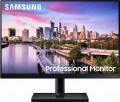Brightness
The maximum brightness provided by the monitor screen.
Choosing
a monitor with high brightness is especially important if the device is going to be used in bright ambient light — for example, if the workplace is exposed to sunlight. A dim image can be "dampened" by such lighting, making work uncomfortable. In other conditions, the high brightness of the screen is very tiring for the eyes.
Most modern monitors give out about 200 – 400 cd / m2 — this is usually quite enough even in the sun. However, there are also higher values: for example, in LCD panels (see "Type") the brightness can reach several thousand cd/m2. This is necessary taking into account the specifics of such devices — the image must be clearly visible from a long distance.
Colour depth
The colour depth supported by the monitor.
This parameter characterizes the number of shades that the screen can display. And here it is worth recalling that the image in modern monitors is based on 3 basic colours — red, green, blue (RGB scheme). And the number of bits is indicated not for the entire screen, but for each base colour. For example, 6 bits (the minimum colour depth for modern monitors) means that the screen is capable of producing 2 ^ 6, that is, 64 shades of red, green and blue; the total number of shades will be 64 * 64 * 64 = 262,144 (0.26 million). An
8-bit colour depth (256 shades for each base colour) already gives a total of 16.7 million colours; and the most advanced modern monitors support
10-bit colour, allowing you to work with more than a billion shades.
Screens with support for FRC technology are worth a special mention; nowadays, you can find models marked "
6 bit + FRC " and "
8 bit + FRC ". This technology was developed to improve picture quality in situations where the incoming video signal has a greater colour depth than the screen, such as when 10-bit video is fed to an 8-bit matrix. If such a screen supports FRC, the picture on it will be noticeably better than on a regular 8-bit monitor (although somewhat worse than on a full-fledged 10-bit monitor, but “8 bit + FRC” screens are much
...cheaper).
High colour depth is important primarily for professional graphics and other tasks that require high colour fidelity. On the other hand, such features significantly affect the cost of the monitor. In addition, it is worth remembering that the quality of colour reproduction depends not only on the colour depth, but also on other parameters — in particular, colour gamut (see below).Sound power
Rated power of the speakers installed in the monitor (see "Built-in speakers"). The higher the power, the louder the acoustics can sound, the easier it is to cover a vast space. However, in most cases, the user is directly in front of the monitor, and high volume is not required for normal hearing. So this parameter is critical mainly for plasma and LCD panels (see "Type").
Power consumption
Rated power consumption of the monitor. Usually, this item indicates the maximum power that the device can consume during normal operation — that is, the energy consumption at maximum brightness, the highest volume of the built-in acoustics, etc. Actual power consumption can be noticeably lower, however, when choosing, it is still best to focus on the value stated in the specifications.
In general, the lower the power consumption, the more economical the device in terms of electricity consumption (ceteris paribus). In addition, this characteristic can be useful when selecting an uninterruptible power supply for a PC and in other specific situations when it is necessary to accurately determine the power consumption of equipment.
Energy class (new)
This parameter characterizes the efficiency of electricity consumption. Classes are designated in Latin letters from A to G, in ascending order of energy consumption. Actually, this was originally conceived, until more energy-efficient models pulled up to class A, which eventually received the marking A +, A ++, A +++. Further development of technologies allowed us to go even further, and in order not to produce pluses in energy efficiency labeling, in March 2021, manufacturers returned to the previous indices from G to A, where A is the most energy efficient monitor. Accordingly, the 2021 models will have modern markings, while older models will be marked in the same way.
External power supply
The power supply, made separately, outside the monitor case — usually right on the power cord (similar to how it is implemented, for example, in many laptops).
This arrangement allows you to take out a fairly significant part of the hardware outside the case. Therefore,
monitors with an external power supply are themselves thinner and more elegant than similar models with a
built-in power supply. On the other hand, the need to look for a place for the PSU itself in some situations can cause inconvenience. Therefore, when choosing, it is worth considering the peculiarities of the situation: in some cases, an integrated power supply may well be the best option.

